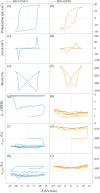Electric-field-induced non-ergodic relaxor to ferroelectric transition in BiFeO3- x SrTiO3 ceramics
- PMID: 37332483
- PMCID: PMC10273322
- DOI: 10.1039/d2tc05100a
Electric-field-induced non-ergodic relaxor to ferroelectric transition in BiFeO3- x SrTiO3 ceramics
Abstract
While BiFeO3-based solid solutions show great promise for applications in energy conversion and storage, realizing this promise necessitates understanding the structure-property relationship in particular pertaining to the relaxor-like characteristics often exhibited by solid solutions with polar-to-non-polar morphotropic phase boundaries. To this end, we investigated the role of the compositionally-driven relaxor state in (100 - x)BiFeO3-xSrTiO3 [BFO-xSTO], via in situ synchrotron X-ray diffraction under bipolar electric-field cycling. The electric-field induced changes to the crystal structure, phase fraction and domain textures were monitored via the {111}pc, {200}pc, and 1/2{311}pc Bragg peaks. The dynamics of the intensities and positions of the (111) and (111̄) reflections reveal an initial non-ergodic regime followed by long-range ferroelectric ordering after extended poling cycles. The increased degree of random multi-site occupation in BFO-42STO compared to BFO-35STO is correlated with an increase of the critical electric field needed to induce the non-ergodic-to-ferroelectric transition, and a decrease in the degree of domain reorientation. Although both compositions show an irreversible transition to a long-range ferroelectric state, our results suggest that the weaker ferroelectric response in BFO-42STO is related to an increase in ergodicity. This, in turn, serves to guide the development of BFO-based systems into promising platform for further property engineering towards specific capacitor applications.
This journal is © The Royal Society of Chemistry.
Conflict of interest statement
The authors declare no conflicts of to declare.
Figures







References
-
- Chen Z. Bu X. Ruan B. Du J. Zheng P. Li L. Wen F. Bai W. Wu W. Zheng L. Zhang Y. J. Eur. Ceram. Soc. 2020;40:5450–5457. doi: 10.1016/j.jeurceramsoc.2020.06.073. - DOI
-
- Rödel J. Jo W. Seifert K. T. P. Anton E.-M. Granzow T. Damjanovic D. J. Am. Ceram. Soc. 2009;92:1153–1177. doi: 10.1111/j.1551-2916.2009.03061.x. - DOI
LinkOut - more resources
Full Text Sources
